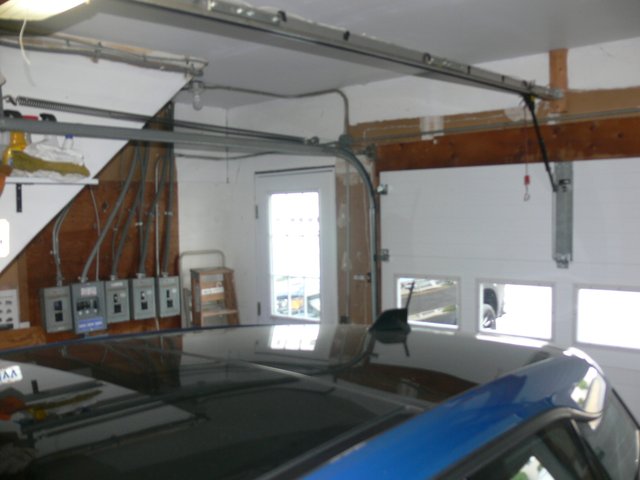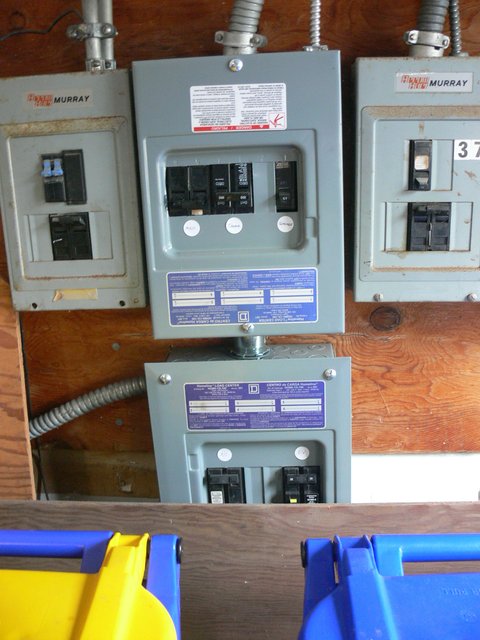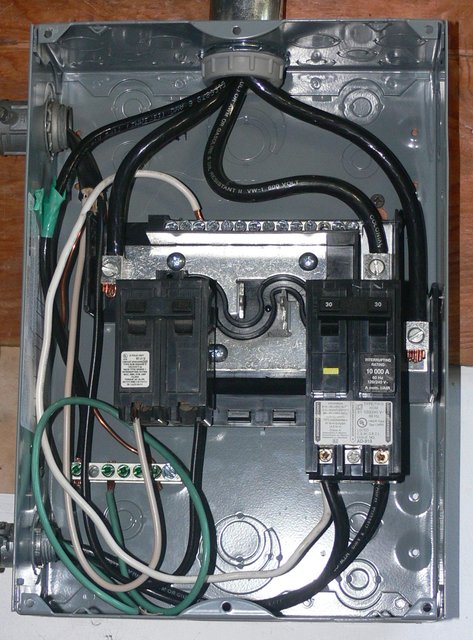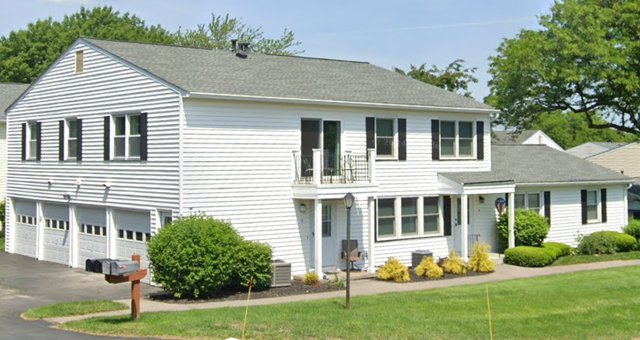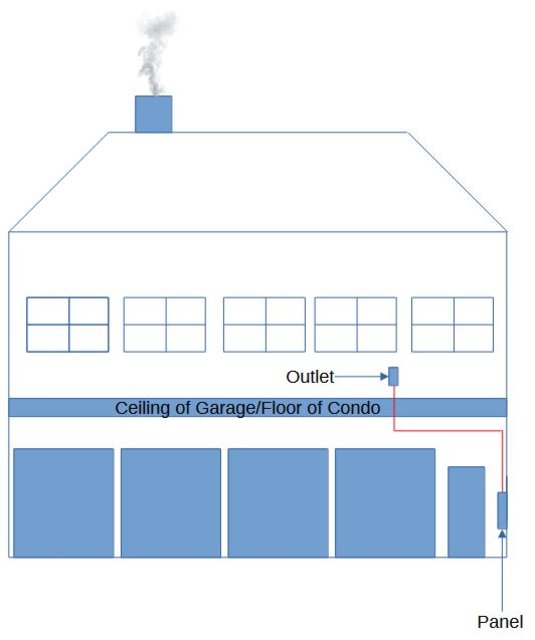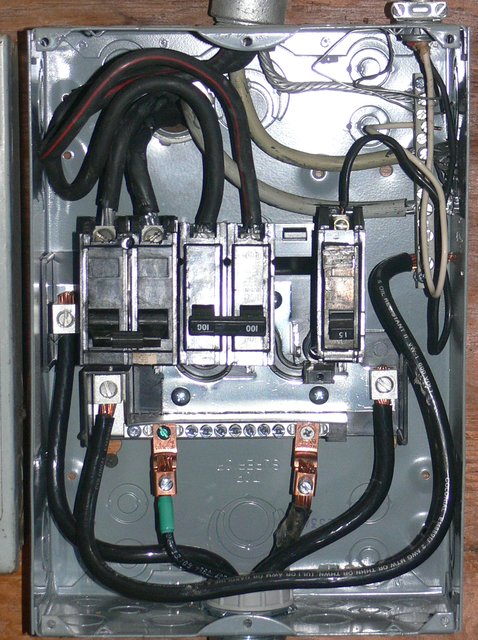Dedicated lines are a great upgrade. Based on all of your questions and rules I think it might be a good idea to get some help from an electrician. Don’t overthink this, plain copper will do the job.
What wire to use instead of Romex
I want to install a dedicated 20amp outlet (likely an AQ NRG). The run from the main panel in the garage to my living room above is relatively short - maybe 25 or 30 feet. Because of HOA rules/regs, I cannot use Romex. Wires in the garage must be inside conduit. I will run 10AWG, but I'm unsure what other specs I should implement. Should I use solid core or stranded? Should it be copper? Is BX the way to go? I've read where using stranded silver or silver tungsten is best, but I'd be concerned about the silver oxidizing/tarnishing over time, especially at the junction points where the wire has no insulation. Is it important to twist the three (including ground) wires or will they perform just as well if run side-by-side?
@roccity Wrote:
NO! Do not use BX for audio see below: For dedicated audio lines I would go with Type MC Galvanized Steel Metal Clad Cable 10 AWG. It has better EMI and EF shielding versus aluminum armor. FWIW, I have four dedicated lines for audio, one for each monoblock amp, one for analog and one for digital. 😎 Mike
|
I'm definitely going to have an electrician do the install for me. I'm okay with working on 110, but I don't trust myself around the main panel! Looking at MC cables on Amazon and HomeDepot.com, they all seem to be aluminum-clad, not steel, and both stranded and solid core copper are available. New Q1: Stranded vs Solid Core? Thanks again! |
Depends on the local code requirements that your HOA is following. In some states, though not common, hollow (metal/Alum) conduit is required to be bent and set, then solid wire fished through. MC flex cables may only be used for certain lengths of runs. It all depends... If you don't know your local code requirements, as said before, consult your electrician first before picking products. A licensed electrician will know the code. |
Use an electrician for installation. But specify the wire. They will think you are crazy, every time I have done it they have. They will refuse to believe that different wire sounds different. I just asked them to humor me. Definitely 10 gauge. I think there is specialty wire. I'm sure someone here will specify it. I used 10 gauge Rolex. Excellent improvement in my system. |
That also may be the AHJ (Authority having Jurisdiction) electrical code in your area as well. In Chicago IL only EMT conduit is allowed in residential housing. MC or AC/BX, nor flexible metal conduit is allowed. Going from memory in NY City, NY Romex is not allowed. You need to contact the Electrical Contractor you will be using. He will know what you can use. Also have a copy of the HOA requirement for him to read. As for using EMT conduit I would suggest you ask the Electrician to twist the Hot and Neutral conductors together before pulling them in the conduit. Pull the EGC, (Equipment Grounding Conductor) along side the twisted pair when installing the branch circuit wiring in the EMT conduit. The EGC could be #12awg green insulated solid copper wire if you use #10awg copper wire.(FWIW, the electrician may tell you you don’t need an EGC insulated conductor in the conduit. Per NEC the EMT conduit is an approved EGC. It’s your call... I would have him install the EGC insulated conductor anyway.
Solid core wire only for the Hot and neutral conductors. Tell the electrician you want solid wire not stranded. He is going to resist the suggestion. Hold firm. .
Did you guesstimate Up, over, across, and down? . Some reading material for you: An Overview of Audio System Grounding & Interfacing Read page 16, and pages 31 thru 36. . Integrating Electronic Equipment and Power Read pages 11, 12, &13. . |
@jea48 @ghdprentice @nwres @zlone @ditusa The distance measurement is a down-over-across-farther down rough measurement. |
MC cable is not made that way. All solid conductors or all stranded conductors. .
Nothing in the NEC code says he can’t twist the Hot and neutral single conductors together before pulling them in the conduit. If the electrician says NEC does not allow it get him to tell you the Article and section... Now the AHJ, has the final say though. .
NEC code doesn’t prohibit pulling NM sheathed cable, (Romex trade name) in EMT conduit. For #10-2 Romex in the garage area the electrician would use 3/4" EMT conduit. Example, #10awg THHN/THWN solid copper wire
Who is paying who for doing the Job? What he should be thinking. If you got the money, I got the time... What are you going to say if he tells you #12awg wire is used for a 20 amp circuit? Not #10 wire. Solid #10 ??? Stranded is all you need. . Did you take the time to look these over? Some reading material for you: An Overview of Audio System Grounding & Interfacing Read page 16, and pages 31 thru 36. Just go to page 31, 32, 33, & page 35. Note, page 35 in the chart shown, the hot and neutral conductors twisted together tested the best, followed by MC cable. . Integrating Electronic Equipment and Power Why use MC cable over Romex? Why twisted twisted pair is better than MC. Read pages 11, 12, &13. . FWIW, NEC code is bare minimum electrical safety standards. NEC could care less how your audio system sounds. Is the electrical wiring installation electrically safe? Code is satisfied.
. |
@jea48 (and @ghdprentice @nwres @zlone @ditusa) I did read from the two sources you linked. To be honest, a lot of it went over my head. Taking everything into consideration, would it be more advisable to: |
A. Use the pre-made steel-clad with all three solid-core wires twisted If the HOA will allow it in the garage. Continuous unbroken run from the Electrical panel to the wall outlet. Problem? I’m not sure where the Electrician will buy the steel armored MC cable. Maybe at an electrical wholesale house??? He may have to buy a 250ft roll, $$$ My guess is the electrician will say he can only get the aluminum armored MC cable. . Southwire, 10-2 MC aluminum armored cable Website. Quote: " THHN/THWN conductors rated 90°C dry available in sizes 14 AWG through 2 AWG, and a green insulated grounding conductor. The conductors are cabled together and a binder tape bearing the print legend is wrapped around the assembly. Aluminum interlocking armor is applied over the assembly." End of quote. .
.
Make sure he doesn’t buy AC/BX cable! You don’t want that stuff to feed you audio equipment! . FYI, though Anti Short bushings are not required by NEC code for MC cable, I highly recommend you tell the electrician you want them installed anyway. If he says you don’t need them. Tell him, you want them anyway. They are cheap and it will take the electrician about 15 seconds to install one.
|
Next week I'm going to stop by a local electrical supply house that I've been to before and buy the cable myself. I should probably get a more accurate measurement in case I can purchase by the foot and save a few bucks versus buying a 50-foot run (if it's even available in that length). I didn't even know about anti-short bushings. Thanks so much for the links. At first I thought it was more like a grommet to line the hole into the panel box. Seeing the video of how they're installed, it definitely makes sense to me to use them. I'll grab a couple either at Home Depot or the supply house, so long as they don't obscenely overcharge for them and if they're not already included with the cable. I'll keep you and the others here in the loop. Have a great weekend! |
Hello- 10 gauge wire matches with a 30 amp breaker in the electrical panel. The possible problem with #10 wire and a 20 amp breaker is that if the copper wire heats up excessively, the breaker will not trip in order to save it, and the insulation around the copper will melt, causing a fire inside the wall. This has been the cause of many house fires. For audio components, this should not be an issue, as they are not heating devices (like space heaters, etc.). |
Not necessarily. Using 10AWG wire with a 20A breaker can help reduce voltage drop.
The wire should never heat up, the breaker should trip at 20A. No problem. |
@roccity said:
You might want to check with the HOA first. Exposed MC cable will not be as pleasing to the eye as EMT conduit. MC exposed kind of looks like installing Romex exposed on a wall. You can support the heck out of it and it still doesn’t look pretty... Questions: How much of the the exposed MC cable will be seen in the garage before it enters the wall of dwelling unit? What is the garage wall finish of the wall it will be installed on? Example, wood studs covered by drywall? Cement block? Other? Horizontal elevation off the floor of the MC cable? Distance down from the ceiling? Is the electrical panel surfaced mounted to the wall? Vertical length of the MC cable above the electrical panel before it is installed horizontally? Can you post a picture of the electrical panel and the area the MC cable will be installed? . |
What you have is basically 10ft extensions of equipment power cords. 10ft of branch circuit wiring does little, if anything, to decouple the power supplies of digital equipment from analog equipment.
I assume you hired an electrician for the electrical wiring installation. Per NEC code when the two receptacles of the duplex receptacle are split and are fed from separate circuit breakers, both outlets shall be de-energized by a single handle action for electrical safety. Single action, use of a 2 pole circuit breaker or two single pole breakers using an approved, Listed, breaker tie. Problem? Just a guess the sub panel is wired as a 120/240V electrical panel. Not a 120V only sub panel. Best practices accepted by many audiophiles, is all 120V audio equipment that will be connected together by wire interconnects, should be fed by circuit breakers that are connected to the same bus, Leg, Line, in the 120/240V electrical panel. All to Line 1 or all to Line 2. Not from both L1 & L2 though. Another problem I see is the close proximity of different dedicated circuits to one another. Therein induced voltage, noise, from the Hot and neutral current carrying conductor of one circuit to the other. Again it defeats the purpose of more than one dedicated circuit to feed audio equipment. I posted this above in this thread, not sure it you read them. Some reading material for you: An Overview of Audio System Grounding & Interfacing Read page 16, and pages 31 thru 36. . Integrating Electronic Equipment and Power Read pages 11, 12, &13. . |
The living room wall where the outlet will be is directly above the garage door. The cable will run from the ceiling of the garage down a foot or so, then to the left over the pedestrian door, along the wall with the panels, and down to the lower of my two panels (wired together to function as a single panel rather than a main and a sub). Or, it could run across the ceiling, then down to my panel. That'd be a shorter run.
Wood studs with sheetrock/drywall, with plywood over it where the panels are.
I haven't taken measurements, but you can probably ballpark them from the photos. And yes, surface mounted panel(s). |
It just occurred to me, your Condo electrical wiring is not fed from any of the load center panels in the photo you posted. Where is the electrical panel that feeds your Condo unit located? I assume somewhere in the Condo. Why are you wanting to fed a dedicated circuit from one of the load centers in the garage? I’m not sure what the feeder ampacity rating is for the load center panel you are planning to use, or the existing loads on the panel. More info is needed. Like where is the panel that feeds your Condo unit in regards to where the new dedicated audio circuit wall outlet will be? |
My condo has a subpanel in the kitchen with individual breakers for the different circuits in my home. The two panels in the garage (the Square-D panels with one sitting above the other) are my main panel. If you look closely, you'll see a 100-amp tandem breaker in the top panel labeled "Condo." This feeds the subpanel in my kitchen. The electric meters are on the exterior of the wall to which the panels are mounted. My thinking is that the total load on my main panel remains the same as I won't be adding any usage but rather just redistributing it, and so exceeding any capacity limit is not an issue. Let me know if this makes sense and clears things up for you. |
I suppose it could, but if I understand what you're asking, that would entail having to cut into the drywall every 16 inches and drill holes through the studs. Running it across the ceiling or walls is simpler and cheaper, if not more aesthetically pleasing. |
@roccity said
OK. .
Edit: " tandem " to 2 pole breaker ( 2 pole 100A, 240V breaker) . I can’t make out what’s written on the labels. It looks like there are a few 2 pole 240V breakers in the two panels. Air conditioning? Water Heater? Electric car charger? Other?. So, The angled GF, flexible metal conduit, out the top of the panel is a 100A feeder that feeds the sub panel in the kitchen. .
OK. Just curious, is there a 2 pole 100A, 240V main breaker outdoors fed from the load side of the electric meter socket? Just curious... Yes, I too would feed the new dedicated 120V 20A branch circuit from the main panel in the garage. (But I will ask is the sub panel in the kitchen closer to where you want to install the branch circuit wall outlet? How much closer?) Will the HOA require you, actually the electrical contractor/electrician, to pull a electrical permit? If yes I wonder if the electrician will be required to install a 20A AFCI breaker in the electrical panel. Hard to tell from the photo but it looks to me like the two panels are Square D QO. I believe a 1 pole 20A AFCI breaker will work, fit, if required. FWIW, From what I have read your area in NY State is still working under the 2020 NEC code. . Downside? Lightning protection. Are lightning storms common in the City you live in? Because of the distance from the branch wall outlet, there in the length of the branch circuit wiring from the main electrical service equipment may be less than 30ft, a plug-in Type 3 point of use SPD (Surge Protection Device) is not recommended (allowed), by NEC, UL, NEMA, therefore the Manufacturer of the Type 3 SPD. IF your area is subject to frequent lightning storms I would suggest you have the electrician install a Type 2 SPD at the main panel in the garage. Top of the line residential Siemens or Eaton Type 2 SPDs get very good customer reviews. . I really would like to know if there is a 2 pole main disconnect breaker outdoors on the load side of the electric meter socket for your electrical service. If yes that is where the electrical service is connected to Mother Earth. . As for this: @rwwear said:
@roccity response:
Hopefully the electrician you hire will be experienced in what he does. Layout, layout, layout... Hopefully he practices the 6 Ps. Prior Planning Prevents Piss Poor Production. His attitude should be he can do anything... If you have the money, he has the time. Question, is there a Condo above yours? Or maybe an attic space? FWIW, I don’t think you are going to like the looks of MC cable surfaced mounted on your wall(s) and ceiling. IF you are married you best run the idea past your wife first... . |
I stand corrected. My electrical knowledge is limited (but I give myself credit for at least not referring to the outlet as "The Holes" like the one shady "electrician" George Costanza hired
There’s a main breaker for the power coming into the panel, one for power going to the main unit, one for a 120v outlet in the garage, one for A/C and one for the 240v EV charger (NEMA 4-50) outlet.
That is correct.
I believe that’s the one that I have labeled "Main" on the left side of the top panel. Outdoors, there’s just the meter.
It’s definitely a much shorter run from the proposed outlet to the garage.
A permit is not needed. I actually spoke with the board president about my plans, and he gave me a verbal go-ahead to do the work without a variance from the HOA. An AFCI breaker would only be needed if the outlet were to be installed in the garage. When I had the outlet installed for my EV charger, I was told by code enforcement that if I had hardwired the charger, a standard breaker would have been acceptable. The idea being that other devices could potentially be plugged into the outlet and then said devices might be left outdoors and exposed to the elements, creating a risk and necessitating the additional protection.
We get a few good storms a year. All electrical in my neighborhood is underground. I’m guessing that reduces the risk, though I’m sure it doesn’t entirely eliminate it.
I just looked up Type 2 SPD’s on Amazon. They’re not tiny. I don’t know if there’d be space in the panel for that as well as the breaker. I admit that I don’t even know how it would connect. I should probably open the panel and take a photo. |
Thank you for your interest, I’m using 4 Single pole breakers with nicely separated independent 12 gauge wires, there is no need or code to use breaker ties, I want them independent. I’ve a 100 amp panel servicing little else, the audio ends at 2 hospital grade outlet boxes (tabs broken code legal). Suggesting this akin to 10 foot Power cables is well… Ridiculous. And finally Decouple Digital from analogue Through your AC wiring and fuse panel ? Are you suggesting home buyers Should revamp the supplied electrical circuit so as to use their audio systems ? That’s a hard cell and certainly on the placebo side of things in my opinion. Thankfully I have clean power there is zero noise. What I do and have done is certified electrician and code approved. My son is a fibre optic engineer, I’m licensed, audiophile fussy and have help. I do believe in diminishing returns and hate snake oil of any kind. I did this to have three of my high-powered boat anchor amps separated should a problem arise. Smaller equipment is independent. Cheers |
| Post removed |
@1971gto455ho said:
2020 NEC Quote: 210.7 Multiple Branch Circuits. "Where two or more branch circuits supply devices or equipment on the same yoke or mounting strap, a means to simultaneously disconnect the ungrounded supply conductors shall be provided at the point at which the branch circuits originate." end of quote. Like I said in my post, it’s an electrical safety thing. . Best regards, Jim . |
100amp
Just did a little Google research and learned what an AFCI is. I'm not sure if code requires it, but if it does, I'm sure the electrician will let me know.
Thanks for the tip!
No. The buildings here are all two stories: 1 ranch unit, 2 townhouse units (living/dining/kitchen downstairs, bath and bedrooms upstairs), and 1 terrace unit (small terrace off of dining room above the front door) with the entire living area (except the front door, a small entryway and a coat closet) above the four garage bays. Above the terrace and townhouse units is a common attic. The ranch has its own attic.
I'm not very worried. As you saw, the garage is not particularly great looking as it is, and it'd be worse - all sheetrock with tape and spackle - if I hadn't thrown up a coat of white paint to brighten it up.
I like the idea of going over spec and using 10AWG. Seems like Wiremold would make the outlet install much easier, but is there a variety that can fit the larger gauge? As far as aesthetics, I could live with a short run (about 12") coming straight up from the floor to the bottom of a surface-mounted outlet box. There'd be no need to run any Wiremold along walls or baseboards. Even if more expensive, using EMT would allow me to follow your recommendation of twisting the hot with the neutral but not the ground. And yes, I certainly want a single run of each wire with no splices.
I will definitely ask how experienced he is with it before going that route!
What I had originally envisioned is an outlet inside the wall like any other, with the wiring going down through the wall and into the garage. Hopefully the Street View image of a building in my complex and my remarkable artist's rendition help you better understand the layout of everything. And once again, thanks for all of your input. It's very valuable and very appreciated.
|
Nice photo of the bottom surfaced mounted electrical panel. How about a photo of the interior of top Main Electrical service panel. That’s the one I wanted to see. Breakers in the Square D panel in the above photo are their Homline style. OK. I like the Square D QO better. The QO has plated copper Bus. Homeline has aluminum bus |
@roccity said:
Is that the extent of the new branch circuit wiring there will be in the Condo? About 12"? I'm confused... Is the new wall outlet in the Condo, on the same common wall with the garage? "coming straight up from the floor to the bottom of a" Is the wall in the condo wood studs with drywall? . |
Both panels were put in to replace the original panel which did not have enough room for another breaker for my NEMA 14-50 outlet for my EV charger. A single larger panel would not fit in between the panel of one of my neighbor’s to the right and the house panel (power for common elements) to the left. I had to go to Home Depot earlier today. While I was there, I did in fact pick up a Homeline breaker to have on hand (20 AMP, single pole).
Yes - wood studs with drywall. Constructed circa 1973/1974.
Yes. It's a short, straight run from the outlet down to the garage - just as it appears in the illustration I created above.
|
Best Practices: It's recommended to use separate, appropriately sized 20 amp circuits with their own breakers and wiring to feed each half of the duplex receptacle. This ensures proper protection and avoids potential hazards. Proper Method: 1. Separate Circuits: Each 20 amp circuit should be run from its own 20 amp breaker in the electrical panel to its respective half of the duplex receptacle. 2. Appropriate Wiring: Use 12 gauge Romex for both circuits, as it is rated for 20 amps. 3. Proper Termination: Ensure the hot (black), neutral (white), and ground (bare or green) wires are correctly connected to their respective terminals on each half of the duplex receptacle. Cheers |
I never thought about doing two runs to one duplex outlet. That's really kickin' it up a notch! I'm going to consider doing that. FYIW: My plan was to plug my stereo power amp directly into one outlet (manufacturer recommends NOT using any type of power conditioner) and my power conditioner into the other, which will have my preamp, DAC and streamer plugged into it. |
Using appropriate wiring and breakers on a split duplex has been around for years and it is most definitely code and designed to be used that way as well. It is essentially no different than using a single outlet on a duplex box. Wiring must be done properly and you have absolutely no issues with safety. |
@1971gto455ho Said:
No it is not. I posted word for word from the 2020 NEC code book. I will look tomorrow for when NEC 210.7 Multiple Branch Circuits, the code edition year it was added to the NEC code book. You may have wired your outlets the way you have them before 210.7 Multiple Branch Circuits was added to the NEC. Best practices is no guarantee that it follows or meets NEC or AHJ code. Your quoted material might be old. It should be updated to meet current NEC code. Or at least for the NEC code edition your state is still using. Please post the Website for the quoted material in your post. . |
Do let me know for curiosity sake, it’s CSA approved here. I also run into many houses where 12 three was used in duplex boxes, that can get complicated and I personally don’t recommend it anymore, but it is legal. And I should add and don’t know that this would make a difference but the four wires and two duplex are in a double box.
|
2011 NEC 210.7 was added to NEC. FWIW, in the US if you wired the duplex outlets as you have them wired before the 2011 NEC was adopted by the state, or AHJ governing body for the county or city you live in, they would be grandfathered in. I have no Idea what Canada electrical code says. FWIW, I usually look up the username of a member before responding to a post of theirs. Don’t know why I missed looking you up. My bad. I wasted your time as well as mine on the subject. I found this doing a quick Google search. CEC Versus NEC: What’s the Difference? . |
@roccity said:
Best and cheapest way is to have the electrician install 10-2 solid copper MC cable. You will save on labor and material. Labor is your biggest cost. He may even be able to run the MC cable up inside the wall and recess the electrical outlet box. Just a suggestion for the electrician use a deep i gang cut-in switch box. He will appreciated the added space for make up of the duplex outlet to the #10 solid wire. FYI if you would like 4 receptacle outlets have him install a 2 gang deep cut-in switch box for two duplex outlets.
|
Sorry, but I strongly disagree with the use of steel clad cables.You don't want magnetic materials anywhere near a conductor! I used a hand twisted pair of solid copper (Simple, I stripped the insulation from 10g Romex) and ran an insulated ground wire seperated by about 2-3" from the twisted pair. Note, I doubt this meets strict code ANYWHERE. If you want to shield the twisted pair more than it is naturally, run it in copper pipe. |
Please be kind to the demo crew that will take your house down in 10 or 25 years and don't do this. There's a reason specific, easily identifiable conduits exist for each purpose: so that future workers will know at a glance what's in it. Running power conductors inside plumbing tubing is complete idiocy. |
| Post removed |
I just stumbled across this thread, I went thru this earlier this year. I bought a large amount of bulk Audience Hidden Treasure AC wire for 4 runs from a panel to my Audio room. My electrician was smarter than me, he added a 50 A sub outside the Audio room that made for very short runs of the Hidden Treasure. First, I would suggest if you are going thru the trouble of adding a dedicated line make it at least 3. One for your amp ( I have monoblocks so I added one for each), one for your digital and one for analog. The one thing I was told about this was to make sure they were all on the same leg (Phase?) of the panel. Not an electrician so don't know what that means. Second, I have a lot of the Hidden Treasure, PM me if you want a good deal on it. I can show you the invoice from The Cable Co. |
I actually plan on doing two duplex outlets. One for the power amp and the other for my Niagara 1200 which has my preamp, DAC and streamer plugged into it. My TV and a couple of other things will remained plugged into my 79 cent 15 amp Home Depot outlet running off of a subpanel along with umpteen other outlets on the same circuit.
I've been told that that's a good idea too. I have a vague idea of what the means, and in a traditional panel with two bus bars, I know that mean to run both breakers off of the same bar, but with my new-fangled panels (see photos above in thread), I'm not sure how to tell whether or not two breakers are on the same leg/phase. I'll certainly clear that up before any work is done. I had an electrician come out the other day who said that the two side-by-side spots in my bottom panel would be on the same phase but couldn't explain to me how he knew that, so that didn't inspire confidence. I have someone else coming out in about 2 weeks who's the nephew of a friend of a friend who is licensed and, by all accounts, knows what he's doing.
Given the layout of my home, a new subpanel would need to be on the wall right between my new outlets (at the same height and I'm guessing surface mounted) or above my garage door in my garage to shorten the run. I don't think I'd like the look of a panel on the wall below the windows in my living room even if it'd be mostly hidden by my TV/hi-fi stand and gear, and I doubt the HOA would like one on the garage wall above my garage door. It'd be a great idea given the right layout though. I took a rough measurement: the total distance from panel to outlet(s) is about 20 to 25 feet. I'll be in touch about the Audience cable. Thanks! |
@roccity said:
They are not on the same Leg, Line. One is on Leg, Line 1, and the other is on Leg, Line 2. He’s not an electrician. Keep looking. Why are you wanting to feed the two new dedicated branch circuits from the bottom panel? I would use the Top panel instead. There is one spare space available. Use this breaker to feed the two branch circuits. Homeline 2-20 Amp Single-Pole Tandem Circuit Breaker Tell the electrician to feed the two new dedicated branch circuits out of the top right side of the panel. Save the top left side for a Type 2 SPD (Surge Protection Device). As I said in an earlier post, A Type 3 plug-in point of use SPD will not work because the length of the branch circuit wiring is less than 30ft. As for this.
As long as the TV and other things are not connected to the audio equipment with wire interconnects. . |


